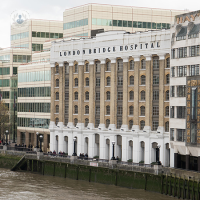Morton's neuroma
Mr Paul Hamilton - Orthopaedic surgery
Created on: 05-03-2013
Updated on: 10-31-2023
Edited by: Conor Lynch
What is Morton’s neuroma?
Morton’s neuroma (also known as Morton’s metatarsalgia or interdigital neuroma) is a painful condition of the foot caused by one of the nerves between the toes becoming irritated and the tissue around it becoming thickened. It most commonly affects the nerve between the third and fourth toes, but can also affect the nerve between the second and third toes.
The pain caused by Morton’s neuroma is often said to feel like you are standing a pebble in your shoe, but the pain can be sharp, and the toes may also sting or experience numbness.

What are the main symptoms of Morton’s neuroma?
There are no outward symptoms of Morton’s neuroma; instead it manifests as painful or uncomfortable sensations in the ball of the foot and the toes, including:
- A sharp shooting pain in the ball of the foot
- A burning sensation in the ball of the foot, perhaps radiating to the toes
- The sensation that you are standing on a small stone or a fold in your socks
- Stinging, tingling, burning, or numbness in the toes
It is recommended that you see a doctor if the symptoms last more than a few days.
What are the causes of Morton’s neuroma?
It is not fully understood what causes the nerves in the foot to become irritated and subsequently thickened, but it is this irritation and thickening that causes the pain associated with Morton’s neuroma. It is thought that the cause is some sort of damage to the nerve, either by over-compressing or over-stretching it.
Some risk factors include:
- Wearing high heels or other tight or ill-fitting shoes
- Certain sports, especially those involving repeated impacts on the foot, such as running and racquet sports
- Other foot problems, e.g. high arches, flat feet, etc.
It is unclear if these factors are direct causes of Morton’s neuroma, or simply things that exacerbate it.
How is Morton’s neuroma treated?
Treatment for Morton’s neuroma depends on the individual case; the doctor will discuss options with the patient based on the severity and how long the patient has had the condition.
Non-surgical options to reduce pressure on the foot or offer pain relief include:
- Change of footwear
- Orthotic devices
- Losing weight
- Injections – steroids or alcohol solutions can relieve pain.
- Painkillers – over-the-counter pills like ibuprofen may be recommended to reduce inflammation and pain.
Not all patients respond to these methods, in which case, surgery may be advised. This may involve removing tissue around the nerve to create more space and reduce pressure, or removing part of the nerve itself.
Which type of specialist treats Morton’s neuroma?
Many orthopaedic surgeons, especially those that specialise in foot and ankle problems will treat Morton’s neuroma. There are also special foot doctors called podiatrists, who have expertise in this area.













